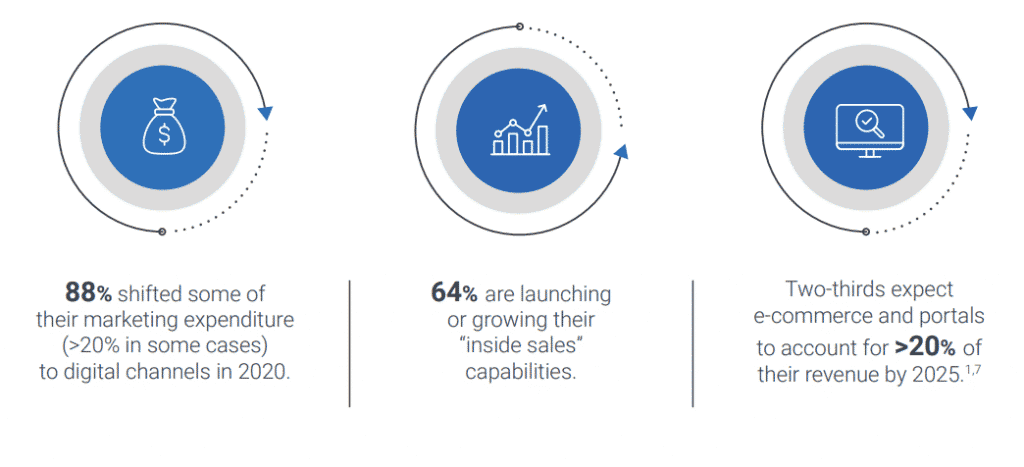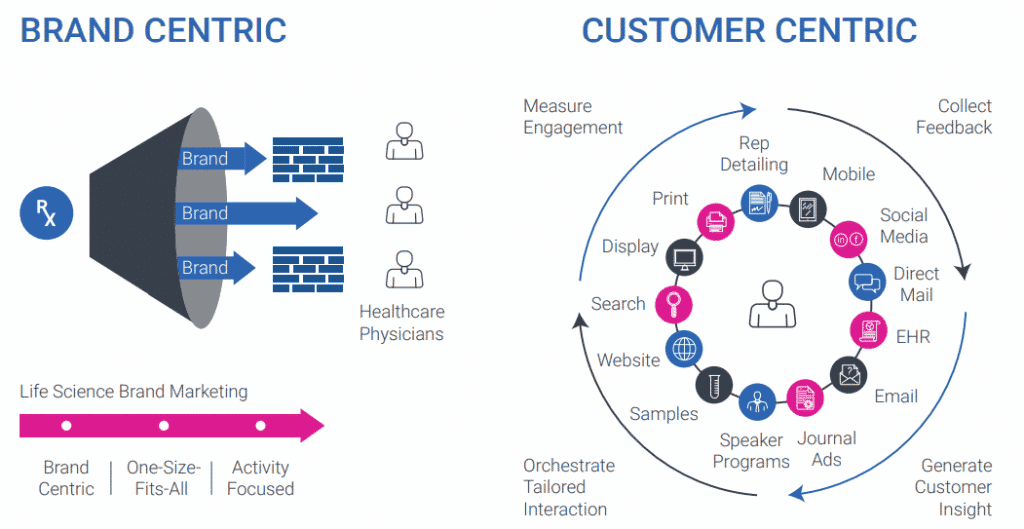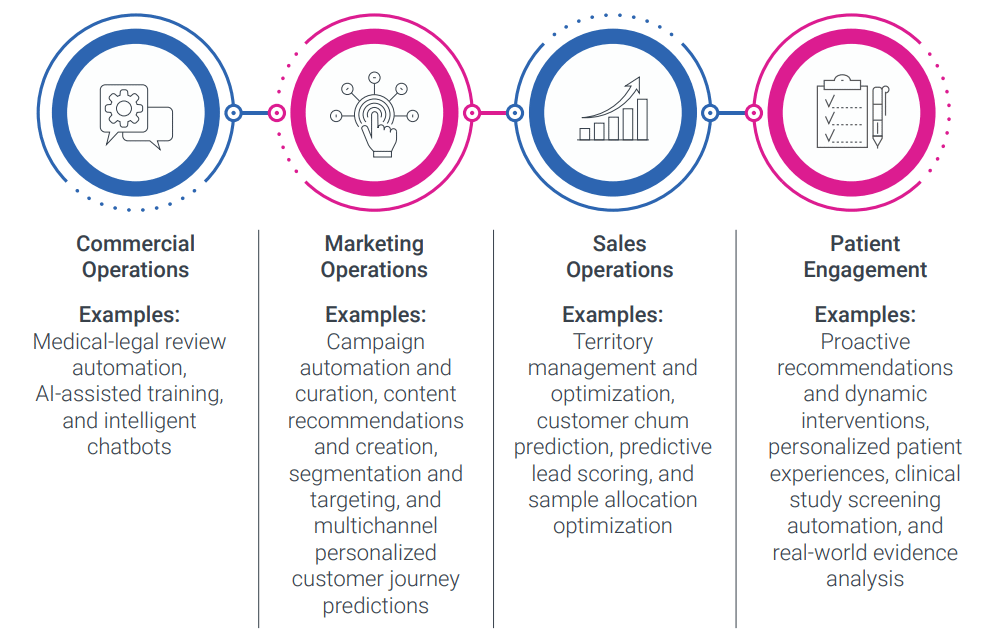The Medical Technology (MedTech) industry is booming. Demand for medical devices is at an all-time high, and it’s not showing signs of slowing down. Due to an increased prevalence of chronic diseases, coupled with more of a focus on early diagnosis, surgical procedures, and advancements in technologies, this market is expected to increase from $423 billion in 2020 to $658 billion in 2028.1
However, as the market grows, so do customer expectations. Physicians and patients are now accustomed to a seamless customer journey that they receive from retail brands like Netflix or Apple. As a result, they now expect the same level of always-on and personalized digital interactions from all organizations. Because of this expectation, MedTech organizations are under pressure to revisit their go-to-market commercial models to improve patient and healthcare professional (HCP) expectations.
Historically, MedTech companies have depended on the effectiveness of an in-person sales channel to bring innovative products to the market, with other channels playing a limited role. Face-to-Face (F2F) interactions allow highly trained representatives to provide vital support to physicians during surgeries, including hands-on training, along with many other essential educational services to deepen the customer relationship.
During the pandemic, restrictions on in-person interactions challenged this model and forced companies to decrease their dependence on F2F representative visits. Today, MedTech is rethinking how to leverage digital channels to provide value and personalized support to different stakeholders.
So how will a digital-first engagement model look like for medical devices? And what are the steps needed for commercial excellence? Let’s find out.
THE DIGITAL SHIFT
In 2020, nearly 70% of Healthcare Providers (HCPs) were considered digital natives, and after a taste of digital interactions during the pandemic, they’re not looking back. 93% of HCPs claimed that they are highly likely or likely to repeat remote interactions post pandemic.2,3 Two-thirds of physicians said that they want fewer in-person engagements with sales representatives than pre-COVID-19 years and more digital contact, with:

Surprisingly, this shift from F2F may have also had an immediate benefit on commercial teams. Virtual meetings are more flexible, require less travel, and can be scheduled at a physician’s preferred time. This virtual convenience allowed meeting times to increase from 3 minutes for F2F to 18 minutes, allowing for more in-depth and meaningful information exchange on vital clinical data.6
The MedTech industry, faced with changing market dynamics and optimistic initial results, recognizes the need to integrate digital practices into commercial and marketing models. According to McKinsey, companies are already planning their investments accordingly as follows:

During the pandemic, MedTech companies had to abruptly adjust their digital, remote, and in-person channels, as they didn’t have an infrastructure in place that fitted a digital-first approach. As a result, 77% of MedTech companies reported experiencing conflict between channels.7 For example, representative-triggered emails rose 5 times during the pandemic with 58% of physicians reporting that at least one company spammed them.5,13
It’s clear from the research; that physicians expect better coordination across digital channels and that relevant content, is easily accessible and tailored to their needs. Physicians and patients expect a well-orchestrated experience, as in their eyes, there is only 1 brand and 1 communication with an organization, which is not yet the case.
Like many in the life sciences space, MedTech companies continue to find it challenging to offer a coordinated communication effort due to operational silos. Customer data are hosted on different platforms scattered across departments that act independently. Marketing, sales, and medical teams work with little to no coordination. As a result, stakeholders receive duplicated messages and fragmented digital health communications from MedTech organizations. This duplication increases a MedTech company’s operational costs along with being frustrating to physicians and patients who expect a consistent customer experience as received from other industries.
That’s why it’s essential MedTech organizations should not amplify digital communications by adding more channels but should implement a connected experience for stakeholders online and offline by following an omnichannel engagement model.
FROM MULTICHANNEL TO OMNICHANNEL
The life sciences world is shifting toward an HCP and patient-centric business model. They recognize that focusing on the customer journey and customer experience rather than on product features is the key to growth.

A large part of the customer-focused shift is enabling HCPs, patients, and other stakeholders on-demand access to information. While representatives can offer tremendous value in their F2F interactions, they cannot be omnipresent for customers. On the other hand, digital channels are available 24/7, allowing HCPs and patients to access information as needed. That is why, to transition into a customer-centric model, a move away from a strategy that relies primarily on in-person interactions must change to one that focuses on enabling channels based on customer preferences and needs.
Another critical success factor is to ensure the customer experience is connected across channels and departments. For example, suppose an HCP interacts with a specific content on your website or social media. In that case, they should receive more content around the topic and representatives should have access to that information to follow up as needed. This personalized content is where the omnichannel engagement model comes into play. Unlike in a multichannel model, where each channel functions independently, in an omnichannel model, all channels are interconnected. As a result, stakeholders can get a personalized experience that maximizes the value they get from every interaction with your company.
By simplifying access to relevant information, an omnichannel model allows HCPs to quickly make educated decisions for improved patient care experience. Not only does this shift improve value to healthcare, but it can also positively impact the return on investment. Research shows that early adopters who have embraced the new omnichannel commercial model achieved 2 to 3 times more revenue.8
MAKING OMNICHANNEL WORK
As stated above, an omnichannel model brings incredible value to MedTech companies, their physicians, and patients. However, making it work is usually hampered by inflexible legacy IT systems that stand in the way of digital initiatives.9 For omnichannel to succeed, it requires a life sciences customer relationship management (CRM) platform with a built-in patient experience module, robust infrastructure, and shift to a multi-touchpoint digital strategy.
Other efforts include moving from representative-triggered emails to self-service portals for on-demand support, virtual and augmented reality for new training experiences, and gamification for learning. E-commerce systems are now part of this pipeline and are gaining traction as a new efficient avenue for order taking. Recently, a genomic sequencing company leveraged its e-commerce channel to directly sell a large capital instrument without any F2F engagement.10
CHOOSING THE RIGHT CRM PLATFORM
A step to shift to an omnichannel go-to-market is also implementing a CRM platform built for the life sciences industry to eliminate data and operational silos. Look for a system that offers a single cloud data model and centralizes your data to enable unified customer profiles along with a built-in patient experience module that physicians can access to serve their patients. With 360° customer profiles, information sharing between different departments or HCPs becomes effortless. This way, all internal and external stakeholders receive the needed support regardless of who they interact with inside an organization.
With a unified data platform, you can apply advanced analytics to create a better experience while also improving operational efficiency.8 Machine learning (ML) models and artificial intelligence (AI)-powered insights help predict what customers are interested in and then seamlessly adapt to their preferences. With this in mind, choosing a CRM with built-in AI and ML capabilities is also key to offering the personalized experience your customers expect. In fact, according to a study by Accenture, 90% of executives recognized AI as important in achieving outcomes such as hyper-personalized experiences and improved levels of efficiency.11, 12, 14

Having a CRM that can eliminate operational silos is equally crucial. Implementing an omnichannel engagement model allows for close collaboration among different functions and capabilities.8 Sales, marketing, medical, and all other departments should have the ability to work together whenever the customer experience or sharing of data warrants their collaboration. Therefore, the platform should have built-in tools that make digital collaboration simple and intuitive.
Channel enablement is another important factor when evaluating customer platforms. Features like compliant 2-way video conferencing allow representatives to offer real-time support to HCPs to reduce the need for on-site F2F interactions. At the same time, self-service portals provide patients and physicians on-demand access to information and can serve up AI-recommended content based on previous interactions.
FINAL THOUGHTS
MedTech companies that embrace or move to a go-to-market omnichannel engagement model will likely come out as leaders in the post-pandemic market.8 While there will always be a place for F2F detailing, organizations can reduce costs and improve revenues while efficiently catering to patients’ and physicians’ preferences with the right mix of digital channels.
Implementing the right CRM technology built for MedTech will play a big part in the on-demand access to information and personalized customer experiences. Modern customer relationship management platforms, such as Omnipresence or Omnicare, offer the capabilities for medical device companies to enable the coordinated, united, and customer-centered engagement model fit for the new era of commercialization.
REFERENCES
- https://www.fortunebusinessinsights.com/industry-reports/medical-devices-market-100085
- https://thejournalofmhealth.com/addressing-the-need-for-digital-engagement-with-healthcare-providers/
- https://pharmaphorum.com/views-and-analysis/designing-hcp-engagement-for-the-next-normal/
- https://www.pharmexec.com/view/the-new-era-of-hcp-engagement-what-s-next-on-the-path-to-digital-excellence
- https://www.medtechdive.com/spons/virtual-selling-expected-to-be-the-new-normal-of-medtech-sales-in-20 22/602303/
- https://www.mckinsey.com/industries/life-sciences/our-insights/omnichannel-engagement-in-medtech-the-t ime-is-now McKinsey Medtech Digital Marketing Survey (100 respondents), February 2020.
- https://www.mckinsey.com/industries/life-sciences/our-insights/the-rise-of-digital-marketing-in-medtech
- https://www.accenture.com/_acnmedia/PDF-130/Accenture-HCP-Survey-v4.pdf
- https://www.gartner.com/doc/3980343
- https://www.bcg.com/en-ca/publications/2021/six-design-strategies-for-medical-technology-next-generatio n-commercial-model
- https://www.gartner.com/technology/media-products/newsletters/Omnipresence/1-24WV7GIQ/index.html
- https://www2.deloitte.com/us/en/blog/health-care-blog/2020/virtual-sales.html
- https://www.accenture.com/_acnmedia/PDF-77/Accenture-Workforce-Banking-Survey-Report#zoom=50
- https://www.gartner.com/technology/media-products/newsletters/Omnipresence/1-24WV7GIQ/ai-power .html
